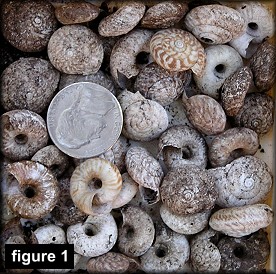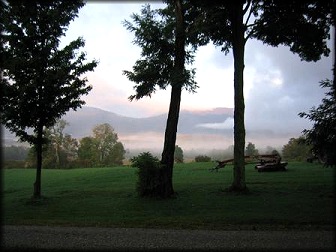| These
quarries began as America's first commercial marble industry. Mining was
begun in neighboring South Dorset by Isaac Underhill in 1785 and
flourished for some 130 years. Dorset marble, as this deposit came to be
called, built the largest marble structure in the U.S., the New York
Public Library, as well as the library of Brown University and Memorial
Continental Hall of the Daughters of the American Revolution in
Washington, D.C. It was also used for over 5000 headstones over the
fallen soldiers at the battle of Gettysburg.
I recalled that the principal stuff of marble, calcium
carbonate, is the mineral terrestrial snails (just as marine and aquatic ones)
use to fashion their shells; consequently these mollusks tend to prosper in
habitats on or very near exposures of this rock. Furthermore, after the demise
of their inhabitants, the empty shells persist in situ far longer due to
the buffering of acidic groundwater that etches and ultimately dissolves their
mineral content. Thus collecting is easy and usually profitable. With geographic
guidance from brother-in-law, Hamilton "Ham" Hadden III, and the company
of Ed Cavin
(Jacksonville, FL), I set out by car to approach the point on the mountainside
we had observed from the patio of the Homestead. This being a well-contrived
collecting trip, our expectations were high. Yet, as we all know, too much
scheming can be a recipe for failure, so our prospects were tempered with various
practicalities such as our fitness for the ultimate assault of the mountain by
foot. First a word about American landsnails, and those of Vermont
in particular. It is apparent that the state has never been a popular
destination for snail-collectors, and very little has appeared in the literature
about its molluscan fauna. Most references are in the form of simple
locality-citations in a variety of works with a far wider geographic scope or in
phylogenetically-restricted studies. In the nineteenth century Charles Baker
Adams (1814-1853)* wrote a few short papers on the state's fauna during his
tenure at Middlebury College (1838-1848) including the years he was the head of
the Vermont Geological Survey (1845-1848). Monographic treatments of the
non-marine mollusca of the other New England states have appeared in the
literature over the last century and a half, but nothing of that scope has been
dedicated to the malacofauna of Vermont.
As a student at Williams College, just over the Massachusetts
line, an hour to the south, I wrote my senior honors thesis (unpublished)
entitled The biology of the testaceous Mollusca of the Williamstown area.
It included reports of three 1961 collecting expeditions to the vicinity of
Pownal, a Vermont town several miles south of Manchester but also in Bennington
Co. One of these three stations was an abandoned marble quarry! A total of 25
species was collected, and we will see below how this assemblage relates to the
efforts in the neighborhood of the Homestead.
In 1985 Leslie Hubricht, an inveterate student of our
country's non-marine mollusks and one-time visitor to the Lee domicile,
published a zoogeographical study The distribution of the native land
mollusks of the Eastern United States. Using literature records, his
personal collections (43,000 lots), and critically-reviewed material in the
leading American museums, he produced appropriately-edited maps showing every
county inhabited (or not) by each of the 523 total species. As expected,
Vermont was not prominently-represented in this work. He demonstrated 49
species from the state, and virtually all of these were found in less than half
the state's counties. Of the 14 counties in Vermont, Bennington was the most
often-represented - with 27 species (based principally on my 25, which I had
communicated to him in the 1970's), of which 15 were found nowhere else in the
state. Second place went to Windsor Co., just to the northeast of Bennington
Co., with 20 species (four unique to the state), and third was Orleans Co., on
the Canadian border, with 12 species (three unique).
 Getting back to the Mt. Aeolus marble quarry expedition....
After being escorted by "Ham" to the trailhead, we debarked afoot and made a 45
minute ascent of the mountain with moderate effort. After passing through a
forest of hemlock, birch, beech, and maple on an unusually straight and
commodious trail, we came in sight of the areas of exposed marble, and I paused
to reflect on what I knew of this formation. It started as limey mud formed by
long extinct invertebrates as they died and sank to the bottom of a shallow
Cambrian sea about 463,000,000 years ago. Later, additional sediments and
collisions between continental plates applied pressure and heat to these limey
strata - metamorphosing limestone to marble. Here we were at the end of our
ascent, and Ed and I immediately noticed empty snail shells for the first time
on the trek. After about a half-hour of our visual reconnaissance and
hand-picking of about five dozen shells
(figure 1) of about ten species, I scooped up several handfuls of the humus
in the rock crevices and stashed them in a one quart ziplock bag. This stuff
was later dried, sifted, and sorted under the microscope and, mirabile dictu,
nearly a hundred more shells were culled. The total species count was a
fairly astounding 23. The list follows (phylogenetic order; scientific name,
author, date of description, official vernacular name;** typeface in
green indicates a
new county record; new state records are indented): Getting back to the Mt. Aeolus marble quarry expedition....
After being escorted by "Ham" to the trailhead, we debarked afoot and made a 45
minute ascent of the mountain with moderate effort. After passing through a
forest of hemlock, birch, beech, and maple on an unusually straight and
commodious trail, we came in sight of the areas of exposed marble, and I paused
to reflect on what I knew of this formation. It started as limey mud formed by
long extinct invertebrates as they died and sank to the bottom of a shallow
Cambrian sea about 463,000,000 years ago. Later, additional sediments and
collisions between continental plates applied pressure and heat to these limey
strata - metamorphosing limestone to marble. Here we were at the end of our
ascent, and Ed and I immediately noticed empty snail shells for the first time
on the trek. After about a half-hour of our visual reconnaissance and
hand-picking of about five dozen shells
(figure 1) of about ten species, I scooped up several handfuls of the humus
in the rock crevices and stashed them in a one quart ziplock bag. This stuff
was later dried, sifted, and sorted under the microscope and, mirabile dictu,
nearly a hundred more shells were culled. The total species count was a
fairly astounding 23. The list follows (phylogenetic order; scientific name,
author, date of description, official vernacular name;** typeface in
green indicates a
new county record; new state records are indented): |


 Getting back to the Mt. Aeolus marble quarry expedition....
After being escorted by "Ham" to the trailhead, we debarked afoot and made a 45
minute ascent of the mountain with moderate effort. After passing through a
forest of hemlock, birch, beech, and maple on an unusually straight and
commodious trail, we came in sight of the areas of exposed marble, and I paused
to reflect on what I knew of this formation. It started as limey mud formed by
long extinct invertebrates as they died and sank to the bottom of a shallow
Cambrian sea about 463,000,000 years ago. Later, additional sediments and
collisions between continental plates applied pressure and heat to these limey
strata - metamorphosing limestone to marble. Here we were at the end of our
ascent, and Ed and I immediately noticed empty snail shells for the first time
on the trek. After about a half-hour of our visual reconnaissance and
hand-picking of about five dozen shells
(figure 1) of about ten species, I scooped up several handfuls of the humus
in the rock crevices and stashed them in a one quart ziplock bag. This stuff
was later dried, sifted, and sorted under the microscope and, mirabile dictu,
nearly a hundred more shells were culled. The total species count was a
fairly astounding 23. The list follows (phylogenetic order; scientific name,
author, date of description, official vernacular name;** typeface in
green indicates a
new county record; new state records are indented):
Getting back to the Mt. Aeolus marble quarry expedition....
After being escorted by "Ham" to the trailhead, we debarked afoot and made a 45
minute ascent of the mountain with moderate effort. After passing through a
forest of hemlock, birch, beech, and maple on an unusually straight and
commodious trail, we came in sight of the areas of exposed marble, and I paused
to reflect on what I knew of this formation. It started as limey mud formed by
long extinct invertebrates as they died and sank to the bottom of a shallow
Cambrian sea about 463,000,000 years ago. Later, additional sediments and
collisions between continental plates applied pressure and heat to these limey
strata - metamorphosing limestone to marble. Here we were at the end of our
ascent, and Ed and I immediately noticed empty snail shells for the first time
on the trek. After about a half-hour of our visual reconnaissance and
hand-picking of about five dozen shells
(figure 1) of about ten species, I scooped up several handfuls of the humus
in the rock crevices and stashed them in a one quart ziplock bag. This stuff
was later dried, sifted, and sorted under the microscope and, mirabile dictu,
nearly a hundred more shells were culled. The total species count was a
fairly astounding 23. The list follows (phylogenetic order; scientific name,
author, date of description, official vernacular name;** typeface in
green indicates a
new county record; new state records are indented):